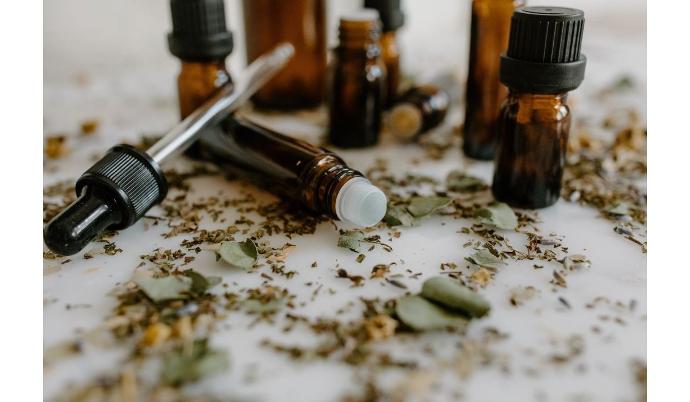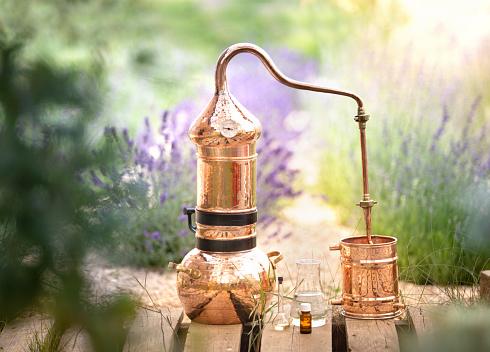Some plants have been known for centuries for their medicinal properties, originally used in decoction or by combustion. Moreover, the Egyptians had set up an extraction process with hot water because they had already understood that extracting this precious liquid facilitates its use.
These extracts therefore contain a concentrated mixture of odorous and medicinal molecules of the chosen plant. Since ancient Egypt, knowledge and technology have clearly evolved and more efficient processes have been developed, but the extraction of essential oils continues to be done on the ancestral model, even if the equipment has evolved. So today, how are essential oils extracted from their original plant? What are the ways to obtain them? Are there techniques that lead to more qualitative essences? Conversely, should we avoid certain methods? We tell you everything!
What is an essential oil?
The world of essential oils is very regulated and there are only a few processes allowed by the pharmacopoeia to give the name of essential oil to the product: these are the ancestral processes of steam distillation and cold expression (pressing) for citrus fruits. Any other process, such as solvent extraction for example, allows the obtaining of a concentrate of volatile molecules, but which will not be able to carry the name ofessential oil
Since 2000, Pierre Franchomme has applied supercritical CO2 extraction to aromatherapy to obtain more complex extracts closer to the plant, because this process is less aggressive (the temperature is lower). Once again, these extracts, although made in the same spirit as the essential oilsThese are called CO2 extracts and not essential oils. In this article we will therefore focus on the ancestral processes of essential oil harvesting.
The different methods of manufacturing oils

Fabrication des huiles essentielles : les procédés par distillation
There are several distillation processes to obtain essential oils. These are all based on the same principle: the plant is heated, in the presence of water or not, to vaporize the molecules which are then recondensed (back to the liquid state) in a cooler. These operations lead to obtain essential oils containing the same molecules, but in different proportions.
Fabrication des huiles essentielles : l’hydrodistillation
This is the ancestral method for the extraction of essential oils. The part of the plant to be extracted (flowering tops, branches, wood, bark) is plunged into a water bath brought to boiling. The steam carries the most volatile compounds upwards, in a tube which is then extended towards a cold water bath. The tube snakes through the cold water bath (serpentine) which allows the essential oil to be recovered in liquid form thanks to the cooling process.
This method allows the essential oil to be recovered in a decantation vase, Florentine or essencier, but also an aqueous phase: the hydrolat (also called floral water). The essential oil and the aqueous phase do not mix, so the two liquids can be separated. To carry out this operation, the quantity of water necessary varies between 2 and 6 times the weight of plant. The essential oil is thus obtained after 1 to about 12 hours of extraction depending on the plant used.
This method is not the gentlest, because the direct contact with water leads to significant changes in the composition of the original essence. Thus, the steam extraction process, which is gentler on the molecules, has been implemented to better respect the plant.

Fabrication des huiles essentielles : l ’entraînement à la vapeur
For this process, steam is used as a means of transporting volatile aromatic molecules. Thus, the plant is not in direct contact with water, which preserves the molecules.
Steam at 100°C allows the extraction of molecules, whose boiling temperatures vary between 160 and 300°C without degrading them. The steam loaded with aromatic molecules is collected in coolers which, as for hydrodistillation, recondense them. This process tends to take longer than hydrodistillation, as there is less contact between the steam and the plant than when the plant is directly immersed in a water bath, but produces essential oils closer to their origin.
However, the contact with steam is not totally neutral, because of the high temperature and the contact with water molecules that favors the degradation of some aromatic compounds. Thus, to avoid this, there is also a dry process that uses no solvent, it is the dry distillation.
Fabrication des huiles essentielles : la distillation sèche
Dry distillation is used for the separation of liquids from solid materials. For the essential oilsThis consists in moderately heating the plants or parts of plants without adding water or solvent, then as for the previous methods, to condense the volatile substances by cooling.
This process has the advantage of taking place at a temperature lower than 100°C, which avoids the denaturation of certain molecules sensitive to the temperature. This method is preferred for the extraction of essential oil from fragile plants such as rose petals or juniper wood.
However, this technique results in extremely low yields of essential oil and can produce polycyclic aromatic hydrocarbons (PAHs), these undesirable molecules resulting from the incomplete combustion of organic matter. PAHs are toxic, carcinogenic and mutagenic (causing DNA mutations), so these oils are not very usable in cosmetics.
Fabrication des huiles essentielles : les procédés d'expression à froid
This technique is reserved for the extraction of citrus essence which is contained in the small pockets on the surface of the citrus skin.
This liquid is in fact the essence of the fruit, which is somewhat abusively referred to as essential oil. Concretely, the extraction of these essential oils is possible by pressing the peels. But in this way, the difficulty is to separate the essence from the skin residue with an acceptable yield. The challenge has been to develop machines to optimize these extraction yields. When it is relevant (
Quand cela est pertinent (orange, citron, mandarine, pamplemousse...), the fruit juice is also recovered, before, after or at the same time as the extraction of the essence. The advantage of this process is that it preserves all the qualities of the original plant, because it is carried out at room temperature, without adding water or any solvent. The essence thus produced is thus perfectly identical to what is produced by the fruit.
Citrus essential oils are photosensitizing and should not be put on the skin before exposure to the sun. However, there are non-photosensitizing citrus essences from which the furocoumarins have been removed.
Fabrication des huiles essentielles : procédé d'élimination des furocoumarines
Furocoumarins are molecules responsible for the photosensitivity of citrus essences, so it is interesting to separate from its components. To do this, the most common process is steam stripping. Furocoumarins are not very volatile molecules and are therefore not easily carried away by steam. Thus, we recover a essential oil in the Florentine vase without the undesirable molecules that remained at the starting point. The mixture thus obtained is thus really an essential oil and no longer an essence. Transformations have taken place in relation to the original composition (mainly in terms of proportions). In terms of appearance, an oil without furocoumarins will be pale, even colorless and perfectly clear, while an essence obtained by cold expression will tend to be dark and eventually cloudy with time.
Thus, when buying a essential oil It is important to check the extraction method, which is a guarantee of quality. If another extraction method than distillation or cold expression is indicated, know that the extract does not "deserve" its name. It will not necessarily be less good, but it will not necessarily be suitable for the use you want to make of it. This could prove to be dangerous in the end. Caution and vigilance are required, as always.



